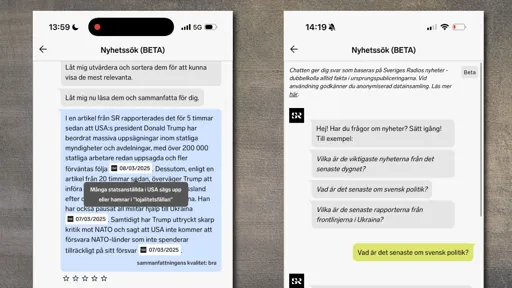
Since March 2025, Svergies Radio (SR) listeners have been testing a new type of news search in the form of an AI-driven chatbot powered by Neo from the EBU. We asked Max Sommerstein, project manager and development editor AI and News at SR, about the project.
tech-i: What does this conversational news search offer to users of the SR app?
Max Sommerstein: It’s a new way for listeners to engage with our journalism – by simply asking questions in their own words. Rather than navigating menus or using keyword searches, users can have a conversation with an AI assistant that understands their intent and offers answers based on relevant, reliable information from SR’s trusted news coverage. It’s a more intuitive, accessible way to explore the news, catch up on a developing story or try to understand complex topics.
tech-i: How does this tool differ from other AI assistants?
MS: While many AI assistants provide quick answers using generic web search results or large language models trained on broad datasets, our tool is specifically grounded in our own journalism. That means it doesn’t guess or speculate – it only provides answers that can be traced back to something SR has published. This ensures the information is reliable, up-to-date, and meets the public service values we hold ourselves to.
tech-i:: What are the main technology building blocks of the tool?
MS: It is built on a retrieval-augmented generation (RAG) architecture. This means it combines the strengths of search and generative AI. When a user asks a question, the system first decides if that question is news- related. It then retrieves relevant pieces of journalism from SR’s editorial content through PEACH, the EBU model we use for our recommender system. After grading and ranking the news articles, the tool uses a language model to synthesize an answer in natural language, always linking back to the original sources. On the backend, we’ve used OpenAI’s GPT model (via API) for the generative component, while all content retrieval is managed in-house to maintain editorial control. The interface is integrated in our app through an embedded widget.
tech-i: What role does the EBU play in this tool?
MS: We’ve collaborated closely with EBU developers throughout this project. SR had already been involved in the news exchange project AEP (A European Perspective); it was the EBU that built the prototype tool (called Neo) and brought it to us. Initially the idea was to test it as an advanced research tool for our journalists, but we quickly saw its potential as an audience-facing feature. Our beta approach – to test a ‘good enough’ version of the tool to get early audience feedback – is thanks to Sébastien Noir and his team at EBU Technology & Innovation, who have been crucial to our success. Most of the development, both frontend and backend, was done by EBU developers. At SR, we’ve worked with design specifics and some development to make the implementation work as smoothly as possible.
tech-i: Can you share any early lessons?
MS: The beta approach, with full transparency, works well with our users, who understand the tool’s capabilities and limitations. We will look at areas to improve, like yielding better results by indexing transcripts and combining semantic and keyword search. We will also be adding more editorial control of the tool with, for example, conversation starters. Later we’ll look at scaling the tool to different kinds of content. After all, if this conversational search is to be of real value, you should be able to come to it with all kinds of questions, not just news-related.
tech-i: Why is this important for public service media?
MS: We feel strongly it’s important to explore AI and to do so safely. If we try to block big tech from scraping our content to use in their solutions (which we do at SR), then it’s natural to look for ways that we ourselves can offer these technologies and solutions – but, and this is the big PSM value, basing it solely on our own trustworthy journalism.
This article first appeared in the June 2025 issue of tech-i magazine.
